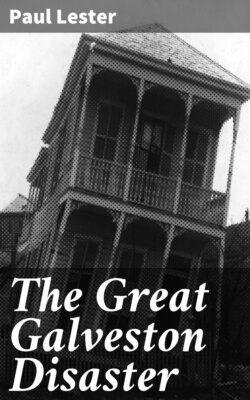Читать книгу The Great Galveston Disaster - Paul Lester - Страница 45
На сайте Литреса книга снята с продажи.
RESISTLESS POWER OF THE HURRICANE.
ОглавлениеTable of Contents
It is a misnomer to call the violent revolving storm which devastated the city of Galveston and the adjacent coast of Texas a cyclone. It was in reality a hurricane, and more specifically what is known to meteorologists as a West Indian hurricane. A hurricane has a much smaller centre or diameter than a cyclone, travels with far greater rapidity, and its blasts often reach a velocity of 100 miles an hour. The hurricane of the West Indies, which is really born in the heated waters of the South Atlantic, and which as a rule curves when it reaches the Yucatan Channel and follows the course of the Gulf Stream, decreases in intensity as it travels further north, broadens in diameter, and becomes the cyclone of the North Atlantic.
It is a curious feature of the Galveston hurricane that, like the great hurricane of September, 1889, which devastated Vera Cruz, it did not follow the course of the Gulf Stream, but curved westward instead of eastward, after passing the Yucatan Channel, and rushed in upon the Texan coast. Galveston was not up to this time considered as within the hurricane belt, and its awful visitation is proof that the laws of storms have exceptions to their rules.
The late Padre Vines, of Havana, the venerable and learned Jesuit priest, who made a lifelong study of the birth and course of West Indian hurricanes, was accustomed to warn by cable the many friends that he had among the captains of the vessels plying to and from West Indian ports of the approach of hurricanes and their probable course.
In September, 1889, he cabled to Captain Joshua Reynolds, commanding one of the Ward steamers, and who was just leaving Vera Cruz for New York, that a hurricane was approaching from the eastward, and that he would better steam slowly to and past Progresso and let the great storm pass up and along the Gulf Stream. Captain Reynolds acted in obedience to the warning, but this particular hurricane, like the one that struck Galveston, curved to the westward instead of to the eastward, after passing the Yucatan Channel, overcame an area of high barometer that, hung over the Mexican coast, and rushed into Vera Cruz, carrying death and destruction in its wake. Captain Reynolds and his ship safely weathered the hurricane and were received at Havana with great rejoicing, where it had been thought they were lost.
It was in 1859 that still another West Indian hurricane curved the wrong way and swept the waters of the Gulf over Last Island, then the great summer resort of Southern society, situated a few miles west of the mouth of the Mississippi off the coast of Barataria. Those who wish to obtain some conception of the horrors attending the Galveston hurricane should read Lafcadio Hearn’s story of “Chita: The Romance of Last Island,” in which that skilled word painter depicts the scenes of the awful tragedy which decimated the households of the South.
